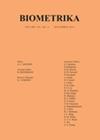具有自适应截断的符合化生存分析
IF 2.8
2区 数学
Q2 BIOLOGY
引用次数: 0
摘要
摘要本文介绍了一种无假设的方法,该方法在剔除数据的情况下为生存时间构造有效和高效的下预测界。我们以cand本文章由计算机程序翻译,如有差异,请以英文原文为准。
Conformalized survival analysis with adaptive cutoffs
Summary This paper introduces an assumption-lean method that constructs valid and efficient lower predictive bounds (LPBs) for survival times with censored data.We build on recent work by Candès et al. (2021), whose approach first subsets the data to discard any data points with early censoring times, and then uses a reweighting technique (namely, weighted conformal inference (Tibshirani et al., 2019)) to correct for the distribution shift introduced by this subsetting procedure. For our new method, instead of constraining to a fixed threshold for the censoring time when subsetting the data, we allow for a covariate-dependent and data-adaptive subsetting step, which is better able to capture the heterogeneity of the censoring mechanism. As a result, our method can lead to LPBs that are less conservative and give more accurate information. We show that in the Type I right-censoring setting, if either of the censoring mechanism or the conditional quantile of survival time is well estimated, our proposed procedure achieves nearly exact marginal coverage, where in the latter case we additionally have approximate conditional coverage. We evaluate the validity and efficiency of our proposed algorithm in numerical experiments, illustrating its advantage when compared with other competing methods. Finally, our method is applied to a real dataset to generate LPBs for users’ active times on a mobile app.
求助全文
通过发布文献求助,成功后即可免费获取论文全文。
去求助
来源期刊

Biometrika
生物-生物学
CiteScore
5.50
自引率
3.70%
发文量
56
审稿时长
6-12 weeks
期刊介绍:
Biometrika is primarily a journal of statistics in which emphasis is placed on papers containing original theoretical contributions of direct or potential value in applications. From time to time, papers in bordering fields are also published.
 求助内容:
求助内容: 应助结果提醒方式:
应助结果提醒方式:


